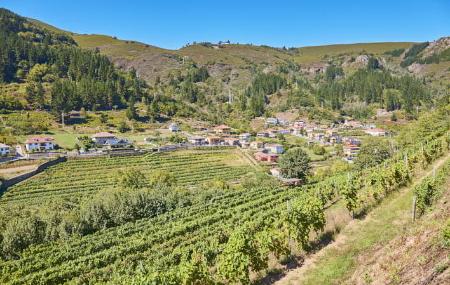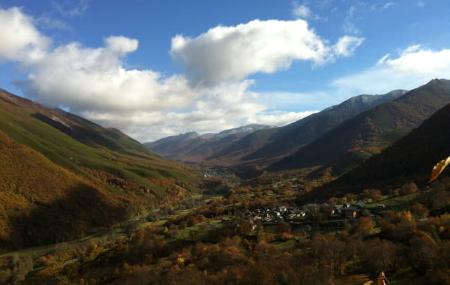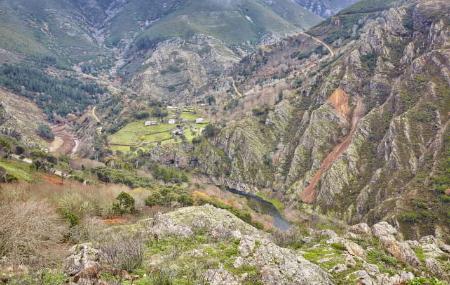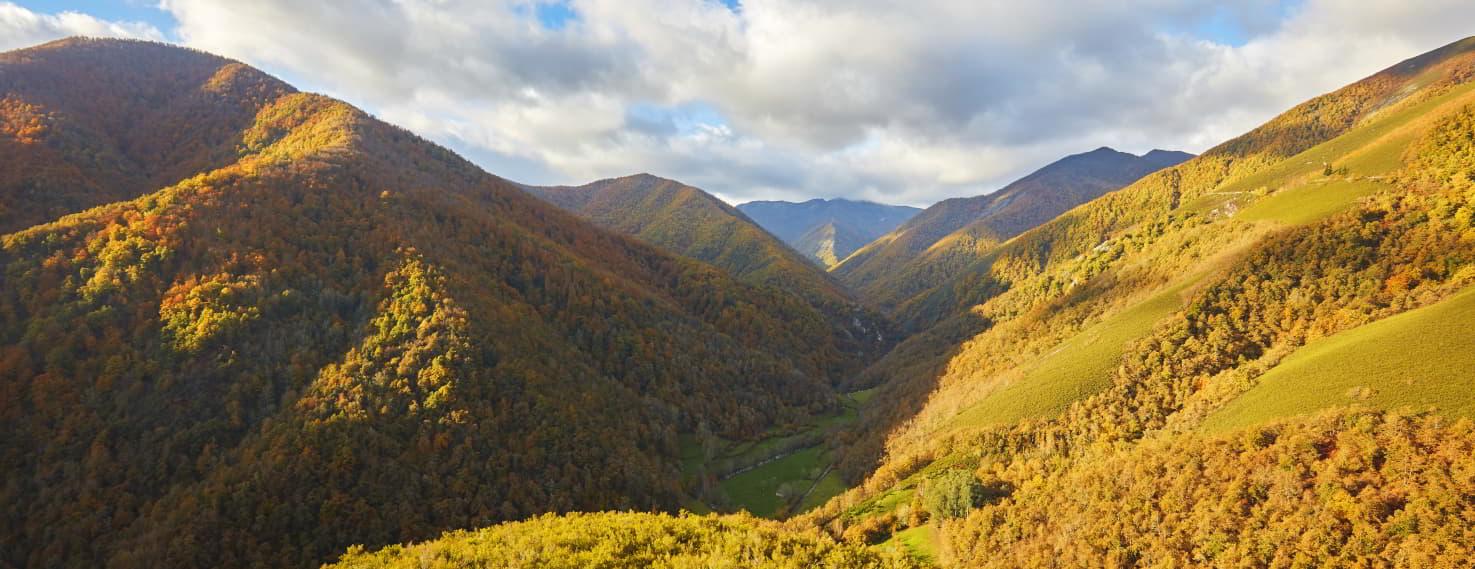
Sources of Narcea

- Title Boroughs it comprises
Sources of Narcea
This region holds a great treasure: the Fuentes del Narcea, Degaña and Ibias Nature Reserve, the largest in Asturias. Its trails lead us through a wild territory, shaped by rivers and ancient glaciers, where the brown bear can still be tracked. In the heart of the park, the Muniellos forest embodies a specially protected biodiversity full of nuances. But it is not all landscape, the traveller will also find here a valuable ethnographic heritage, and one of the most intense moments of the Asturian summer: the "Descarga", when Cangas del Narcea explodes with gunpowder and emotion. Then - and whenever the occasion arises - a toast is made with this local wine, cultivated on steep slopes and the fruit of a unique microclimate.

Natural environment and biodiversity
The Fuentes del Narcea, Degaña and Ibias Natural Park covers more than 550 km². The Narcea and Ibias rivers, together with their numerous tributaries, shape the terrain and nourish life, especially in these large oak and beech forests, with an authenticity difficult to find in other parts of the continent. Wildlife and humans coexist here in a rare harmony.
Fuentes de Narcea, Degaña and Ibias Natural Park
Some call this park the Yellowstone of Asturias. A bird's eye view of its vast expanse reveals a rugged tapestry of mountains, gorges, meadows, deep valleys and endless forests. The limits of the park cover a large part of the south of Cangas del Narcea, all of Degaña and an eastern strip of the council of Ibias. A generally sparsely populated geography that has been the best ally of the brown bear, the wolf, the martens, the wild cats or the Iberian desman, that shy inhabitant of the rivers, between mole and shrew, which is in danger of extinction.
The Park House, located in the old stables of the monastery of Corias (Cangas del Narcea), disseminates the natural and cultural values and the regulations of this natural space. With its guided tours and five themed rooms, with panels, audiovisuals and models, it tells us the details of one of the most biologically rich areas in the Cantabrian mountains.
The forest of Muniellos
In order to enter this forest diamond, you have to ask permission. The rule is set by the administration, but it seems that it is nature itself that hangs the "full" sign to remain intact. Only twenty people a day can visit it, and so it remains the best preserved oak forest in Europe. You can consult here the guide to visit the Muniellos forest.
We are talking about an Integral Natural Reserve of almost 55 km², surrounded by peaks of 1,500 metres, with a forest where endemic lichens known as "capuchin beards" - a sign of exceptionally pure air - grow. Declared a UNESCO Biosphere Reserve, this forest is a living vestige of what was, centuries ago, the essence of the Cantabrian Mountains.
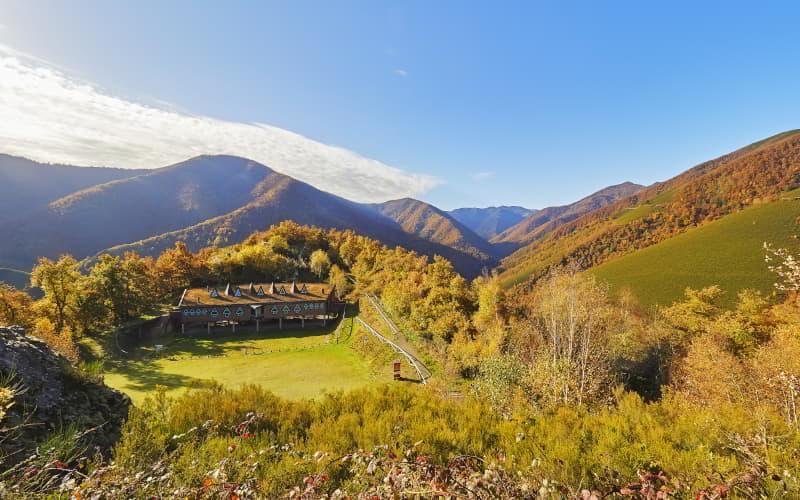
Access to Munieḷḷos starts at Las Tablizas, some 20 km from Cangas de Narcea, where the Visitor Reception Centre is located. From here starts a 500-metre self-guided trail, with information panels (also in Braille), which prepares the walker for what is to come: a demanding 20-km circular route that links old forest tracks with glacial lakes such as La Grande, La Isla, La Honda and La Peña - or the more remote Peñabelosa and La Belosa, which only appear in the wet season. The itinerary, from oak to heather and from birch to beech, is a botanical festival that begs for silence. Among the landmarks, the Roblón de Fonculebrera and the Xardón de la Candanosa. Nearby are the Candanosa viewpoint itself and the Muniellos Interpretation Centre, installed in an old quarry and equipped with interactive rooms, projections and models.
Cuetu d'Arbas
At the eastern end of the Park, mountain ranges such as Degaña, Oubachu or Xinestosu reach their peak at Cuetu d'Arbas (2,002 m.), a natural viewpoint towards Somiedo, El Cornón and, on clear days, the Ubiñas. Its summit and surroundings form a 29 km² Partial Nature Reserve, with unique geology, subalpine vegetation and a clear glacial footprint that can be seen at every step. From El Puertu (Puerto de Leitariegos, the highest village in Asturias), the summit can be reached by a short route that requires good boots. Along the way you will see peat bogs, cirques, ridges and several mountain lakes. Arbas appears after a 35-minute walk and is the best known, although Reconcos - the last peninsular refuge of the yellow water lily -, Chauchina, Changreira or Veiga de Palo also stand out, each with its own microcosm.

Nature routes through Fuentes del Narcea
In addition to the routes through Munieḷḷos and the Cuetu d'Arbas, this region offers more than 300 km of signposted trails: a real paradise for hikers. The Moal forest route, without going any further, is perfect for those who cannot get a place in Munieḷḷos. It starts in the village of the same name - Exemplary Village of Asturias in 2018 - and climbs among chestnut and oak trees to a solemn and humid beech forest, where the light filters in shreds and creates a captivating atmosphere. The path takes us to the El Montecín viewpoint, where we can look out over the Mual valley and the protected domains of Munieḷḷos. Another way to see this reserve is from the village of Pousada de Rengos. This is the starting point of a 15 km circular route that climbs up to the Agua Blanca waterfall, continues along the Pandu mountain range and runs along a ridge from where we can enjoy good views over Munieḷḷos and the Naviegu valley.
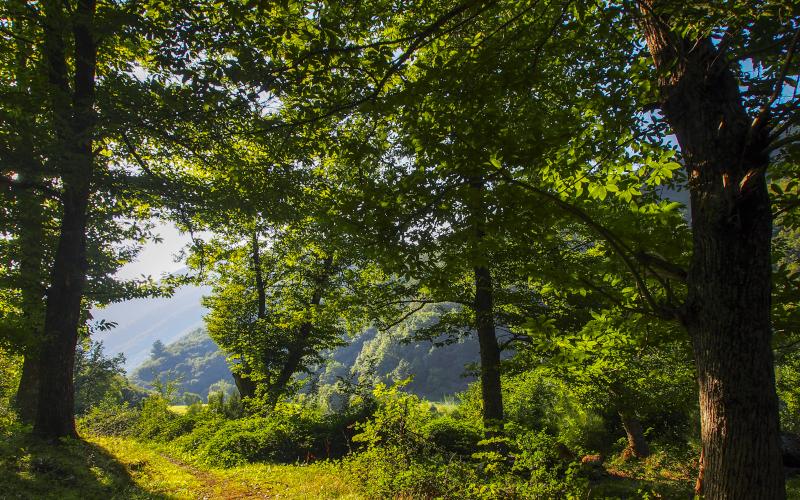
Another obligatory route through the forest is the beech forest of the Monastery of Hermo, which, with its more than 1,500 hectares (almost half the size of Munieḷḷos), is the largest "fayeu" in Asturias and one of the largest on the peninsula. Its vegetal vault is so closed that it prevents the undergrowth from growing, sheltering an elusive fauna (from maple trees to bears). It also exudes an arcane air: it seems that witches used to celebrate covens in the nearby Vega del Palo.
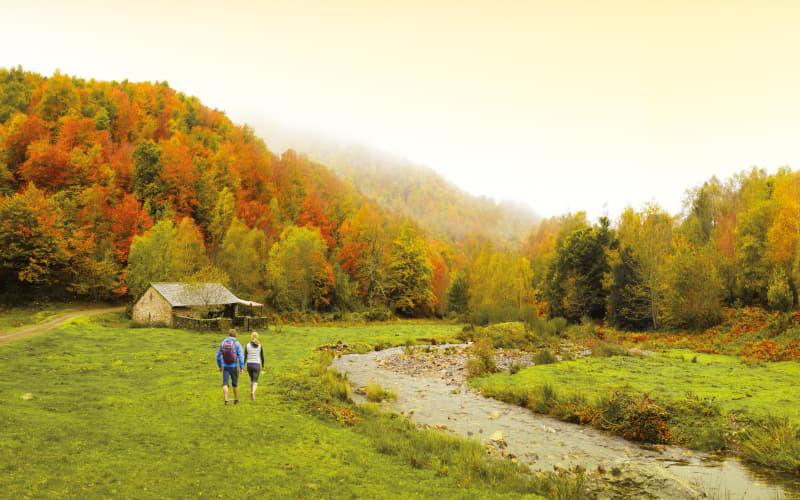
For mountain bike lovers, there is no shortage of routes and challenges in this region, especially in the valleys along the Coutu river, from where you can climb peaks such as L'Artosa (720 m) or Oubachu (848 m). Another more demanding option takes us to the peaks of Ibias, on a circular route that starts in San Antolín and passes through Cecos, Peña de Tuña, Chao da Serra, Chao d'Arqueira and Caldevilla.
Cycle touring, on the other hand, is a magnificent way of getting to know the territory at a different pace. The climb to Altu L'Acebu ( 1,206 m) is a must, with spectacular views and a stop at its famous sanctuary. Also worthwhile is the Ruta de los Puertos, which crosses Pozu las Muyeres Muertas or El Connio, combining tough ramps, unique landscapes and passes close to Munieḷḷos. The region of Fuentes del Narcea also offers other cycling tourism proposals that are worth exploring.
Ecotourism activities and routes
With a natural heritage of such calibre, it is not surprising that the region protects itself and promotes responsible tourism that respects both the environment and the people who live there. Here, nature interpretation is much more than a tourist activity, it is a form of sensory literacy. Professional guides will teach us to distinguish a broom from a gorse, to read in the folds of the terrain the history of the glaciers or the Roman mining heritage. They will also show you how to clearly discern the tracks of a bear.
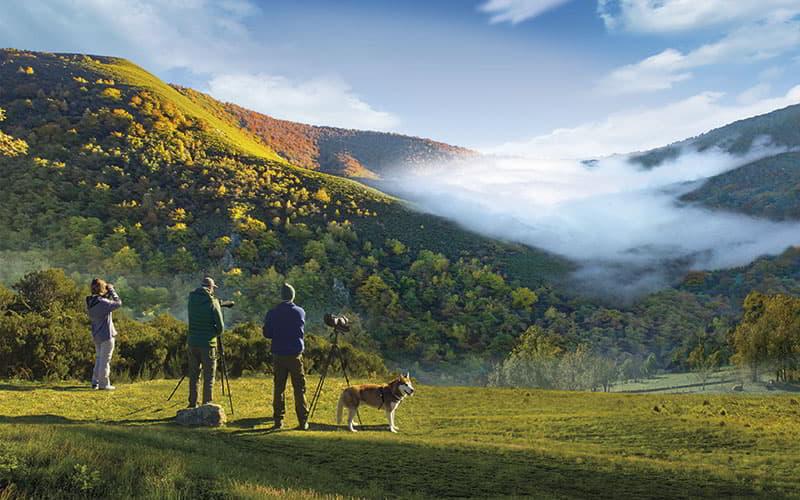
Wildlife sightings
In these lands, wildlife breathes freely and reminds us that the forests were already theirs before there were maps. The Cantabrian brown bear lives on its own and in increasing numbers - there are already some 250 in the western area, tripling its numbers since the 1990s. This is one of the few places in Europe where, with patience and a good pair of binoculars, you can see the bear in the wild. It is also possible to listen to the howl of the wolf or follow the trail of the wild cat, always paying attention to the indications and advice of the local guides. They teach us that it is not necessary to "see" to "feel" nature: it is enough to be attentive, to listen, and to observe without making noise. The animals hide, but they leave signs that we can learn to recognise and enjoy.
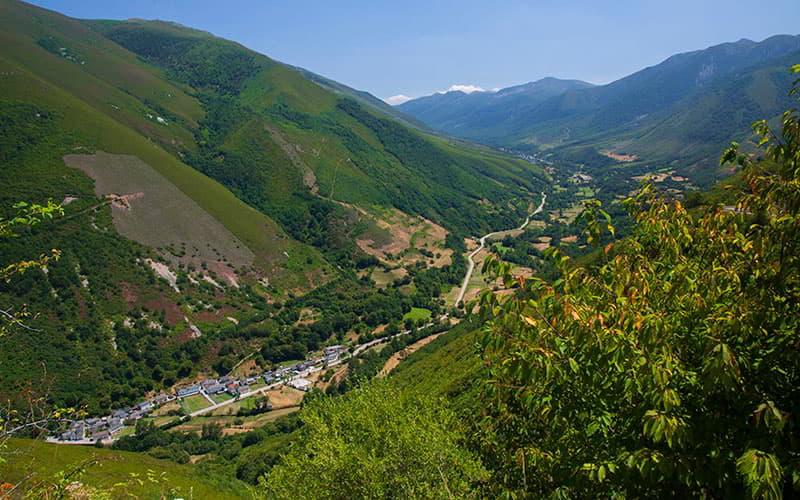
In any case, the best times to observe wildlife are at dawn and dusk, when the forest is active. At viewpoints such as Fonduveigas (Degaña), which opens up in the middle of the AS-15 like a window onto the forest, you can see chamois, wild boar and, with a bit of luck, bears or wolves. Nearby, the Alto El Capillo viewpoint opens up a magnificent view over the valleys of Degaña, where you can immediately recognise the signs of traditional grazing.
Ethnographic heritage
Behind the trail of fauna, nature gives way to centuries of human history. From the Neolithic dolmens of Pradias or Seroiro, through fortified settlements such as Valcabu, Cecos or Degaña, to the Roman gold mines of El Corralín and San Fliz. In the Middle Ages, the Monastery of Corias was the spiritual and winemaking engine of western Asturias, and palaces such as those of the Counts of Toreno, in Cangas de Narcea, or Tormaleo, in Ibias, were built.
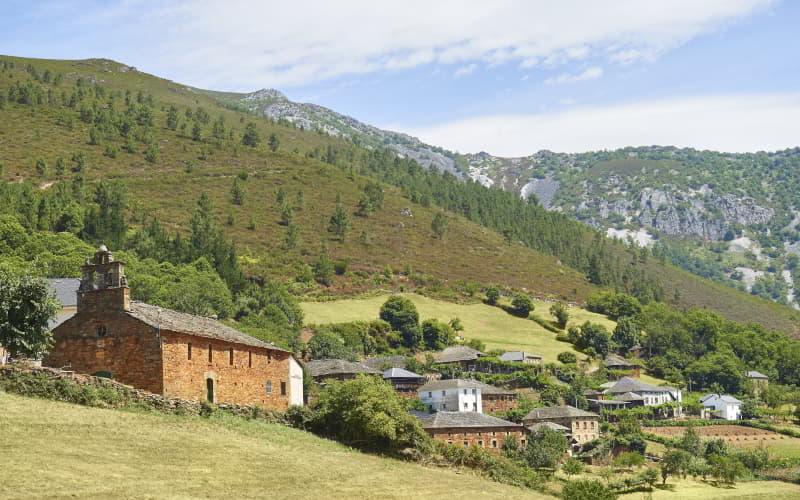
In Degaña and Ibias, the villages still clearly show their pallozas de teito, cortinos, mills and calechos. Localities such as Xinestosu, Riodeporcos, Sisterna or Trabáu conserve not only their traditional architecture, but also the artisan knowledge of traditional Asturian trades: madreñeiros, cesteiros or cunqueiros - the latter made homemade wooden utensils which they sold at fairs in Castile, Extremadura or Andalusia, and among them they spoke tixileiro, a guild jargon. Also potters like those of Ḷḷamas del Mouru, in Cangas de Narcea, who are still making history with their black pottery: pitchers, bowls and caveros fired and dyed with the drowned smoke from the kiln. Only 17 km. from the town of Cangas, Besullo/Bisuyu preserves its traditional architecture intact and boasts a historic hammer where the old ironworkers forged iron in some twenty workshops. The traditional history of this and other trades is narrated in the Visitor Reception Centre "Alejandro Casona" -the famous playwright of the 27th generation has his birthplace in this village-.
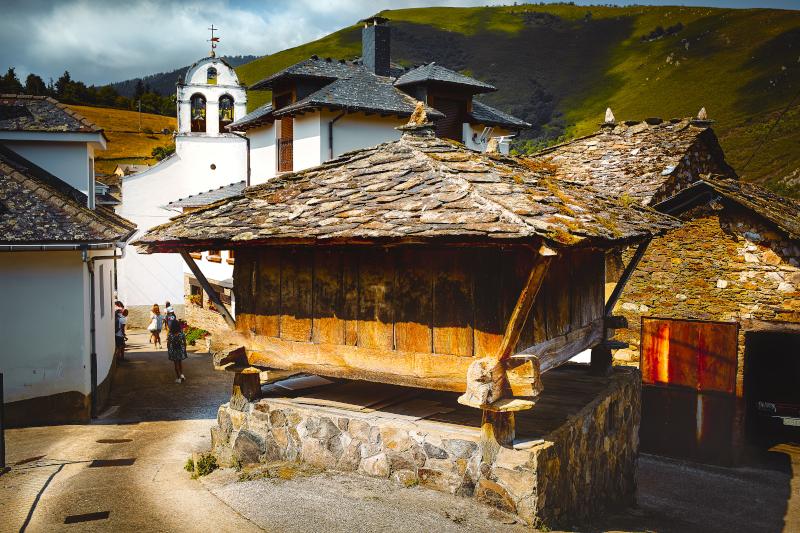
To get to know the ethnographic heritage of the area even better, it is worth visiting the "Casa Florencio" Landscape Interpretation Centre in Cerredo (Degaña), a 19th century mansion with a granary and chapel which today houses temporary exhibitions and the Tourist Office itself. On the other hand, in San Antolín de Ibias, the Aula de la Naturaleza explains the history, landscape and customs of the area; right next to it is the Palloza, a traditional house with a round floor plan, thatched roof and heir to the old castreño constructions. The Ruta del Oro (Gold Route) starts from this very spot, which takes advantage of the layout of ancient Roman roads and passes through centenary vineyards, water mills next to the river Ibias and beehives surrounded by cortinos, those stone constructions designed to protect the hives from bears. Part of this rural heritage can also be enjoyed on the simple route from Courias to El Puelu, in the vicinity of the town of Cangas.
Practical advice for visitors
Cangas del Narcea, just two hours by road from Oviedo/Uviéu, is the gateway to a region that changes with the seasons: spring greenery, bear watching in summer, forests and grape harvesting in autumn, and snowy landscapes in winter, with skiing in the nearby Leitariegos resort in León.
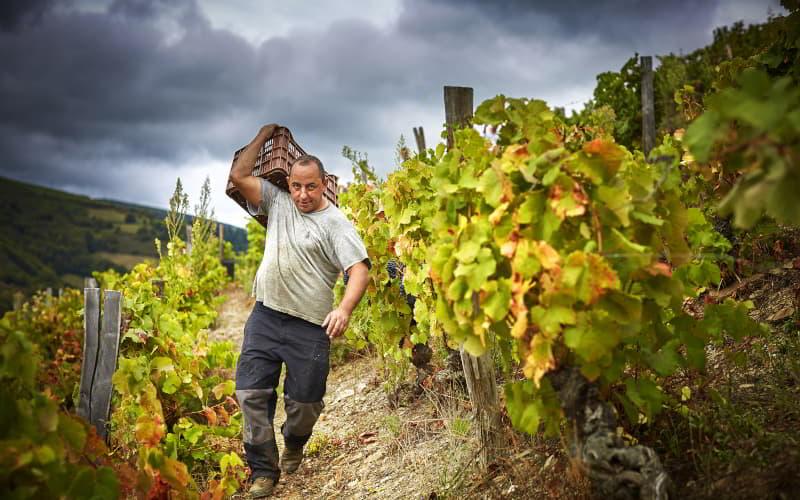
It is best to stay in gîtes, where the hospitality is as authentic as the scenery. Here you can wake up at dawn amidst vineyards and forests, and enjoy breakfast with real honey. If at the beginning of the day we are still not sure which route to take, and we have not had time to book ecotourism activities such as those mentioned in this report, we can always take the AS-348 road to Puerto del Connio. At kilometre 11 there is a discreet lay-by that offers us the most sought-after panoramic view: the Muniellos oak grove. It is also a good idea to visit the Sanctuary of L'Acebu, one of the most venerated in western Asturias. From the viewpoints surrounding the chapel you can enjoy panoramic views of the council of Cangas del Narcea, the largest in surface area in the whole autonomous region and the second largest in Spain.
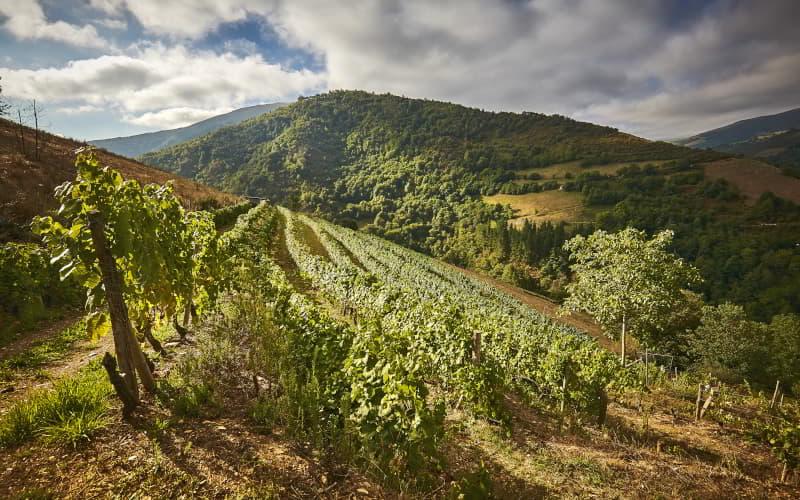
The streets of the town of Cangas del Narcea, always lively, reflect the life of the whole region and encourage you to discover emblazoned houses, good food and places with character. On 16th July, the celebration of Nuestra Señora del Carmen - La Descarga, a festival declared to be of Tourist Interest in the Principality of Asturias, is an unparalleled event, with tens of thousands of "voladores" exploding in unison and causing a sonorous earthquake that makes the ground tremble. At the beginning of August, the summer takes on even more body with the Prestoso Fest(opens in a new tab), an event that blends indie music (concerts by national stars, international bands and acclaimed DJs) with visits to wineries, gastronomic experiences and nature trails. The name says it all: "prestoso" in Asturias is something we like a lot.
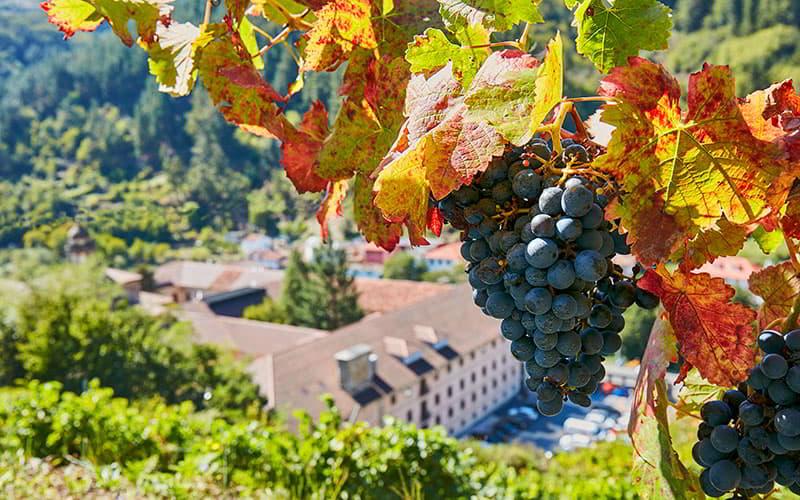
Just three kilometres from the town of Cangas, the monastery of Corias - today a Parador Nacional - is a reminder that viticulture has been practised here since the Middle Ages, thanks to a tradition started by the monks. After its splendour in the 19th century and the phylloxera epidemic, the wines of Cangas have been reborn with their own designation of origin (DOP Cangas), made with very characteristic native varieties such as Albarín Negro, Carrasquín and Verdejo Negro. On impossible slopes of over 30 degrees, the grape harvest is a feat to be celebrated in style, as is the case with the Cangas Wine Harvest Festival, declared to be of Tourist Interest in the Principality of Asturias. The Wine Museum and the wineries in the area allow visitors to discover this heroic tradition and get an introduction to the local wines, which have their natural continuation in the wineries, where theory becomes direct experience. The wine goes wonderfully with the culinary delights of the region. Local sausages with the intense flavours of the pig: andolla, chosco, butiellu or cachola; cabbage stew, fish from the riverside preserves, red meat from the Asturiana de los Valles breed, game dishes with wild boar, roe deer or partridge, all accompanied by a generous native vegetable garden.

The municipality of Ibias, which is on the border with León and Galicia, preserves an intact rural world. Pallozas, covered granaries and villages full of character such as San Antolín (capital of the council) and others such as Riodeporcos or Pradías. Degaña, a glacial valley of persistent greenery, still shows the intense Roman activity in search of gold using the "ruina montium" technique. The soul of this council can be found in Degaña itself (its main centre) and in villages such as Zarréu or Trabáu, as well as in viewpoints such as La Corza or El Oso and recreational areas such as La Collada, where every June the Fiesta de la Collada is held, a gathering that brings together locals and visitors around food and craft stalls, bagpipe music, a livestock competition and horse shows. In the evening, a shared "queimada" under the stars.
Another beauty of this council is the route Por donde camina el oso (Where the bear walks), which winds its way, between oak and centenary chestnut trees, along a path that connects Sisterna (Ibias) and Zarréu (Degaña), villages where the inhabitants share this road with such an emblematic species as the bear, which lives in the area. Enormous chestnut trees, lichens that give us an idea of the purity of the air, the building of an old power station in the middle of the forest, or vestiges of Roman mining are some of the surprises on this route. Where the bear walks is a linear route with little gradient, although it is almost 20 kilometres long. So perhaps the best thing to do is for each person to adapt it to their physical preparation, and if they don't do the whole route, they can walk the section that best suits their abilities.
Cangas de Narcea, Ibias and Degaña form a region where every corner demands your attention and your time.
Images
Map
What to see
- Parador de Corias.
- Wineries, vineyards and the Cangas del Narcea Wine Museum.
- Routes in the Nature Reserve of Las Fuentes del Narcea, Degaña and Ibias and the Muniellos Integral Nature Reserve.
- Degaña Valley. Bear watching.
- Craftsmen: Virgen de los Remedios ( Pambléi - Cangas del Narcea) and Ceramica Negra de Llamas del Mouro (Ḷḷamas del Mouru - Cangas del Narcea).
- Riodeporcos, Alguerdo, Uría, etc. Walled villages in Ibias.

